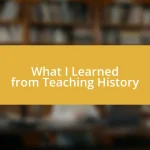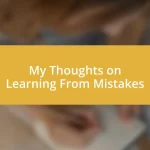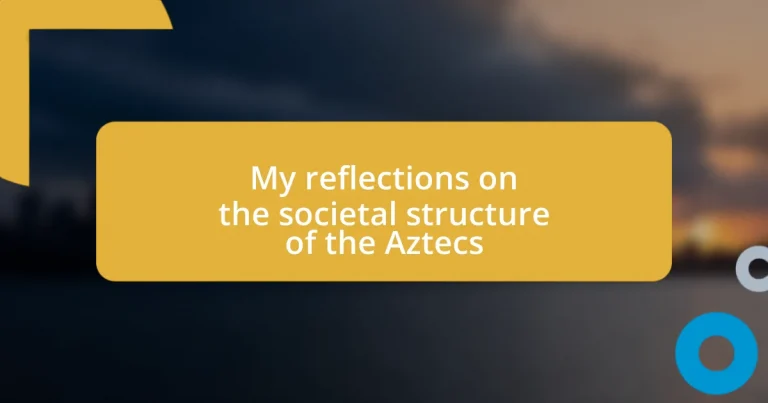Key takeaways:
- Aztec society was structured around a strict class hierarchy with significant roles for emperors, nobles, warriors, and commoners, influencing governance and community interactions.
- Religion was integral to daily life, with priests leading ceremonies that united the community and reinforced a shared purpose, reflecting the importance of faith in societal cohesion.
- The legacy of the Aztecs includes advanced agricultural practices, rich artistic traditions, and governance innovations, which continue to resonate in modern societal structures and cultural expressions.
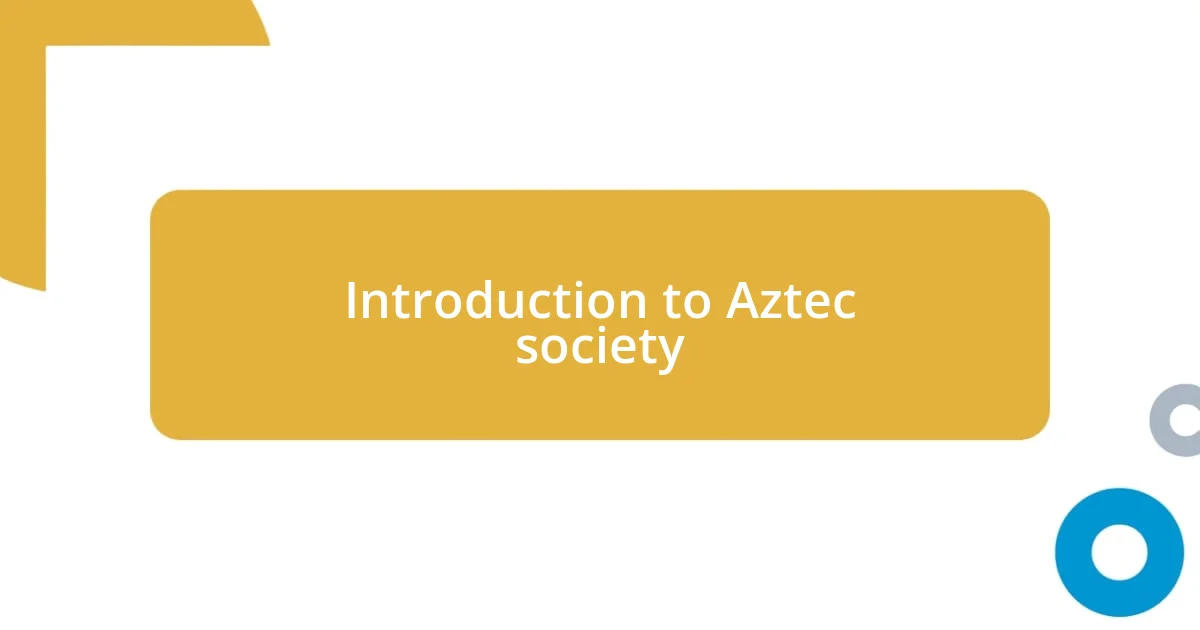
Introduction to Aztec society
Aztec society was a fascinating tapestry woven from complex beliefs, fierce traditions, and a highly structured hierarchy. I often find myself marveling at how they combined spirituality with daily life, where every social role contributed to a greater cosmic order. Can you imagine living in a society where your status was part of a divine plan?
The Aztecs organized their society around a strict class system, which included nobles, priests, warriors, and commoners. As I delve deeper into this, I can’t help but reflect on how this stratification influenced their culture and community interactions. It makes me wonder: how would our current society shift if we embraced a similar interconnectedness in our roles?
At the core of this society was the vibrant connection to their gods and the land, which shaped everything from governance to agriculture. I vividly remember first learning about their elaborate rituals and sacrifices, and feeling a mixture of awe and disbelief at the lengths they went to honor their deities. This deep-rooted spirituality is not just historical; it prompts us to ask what we might be neglecting today in our pursuit of meaning and connection.
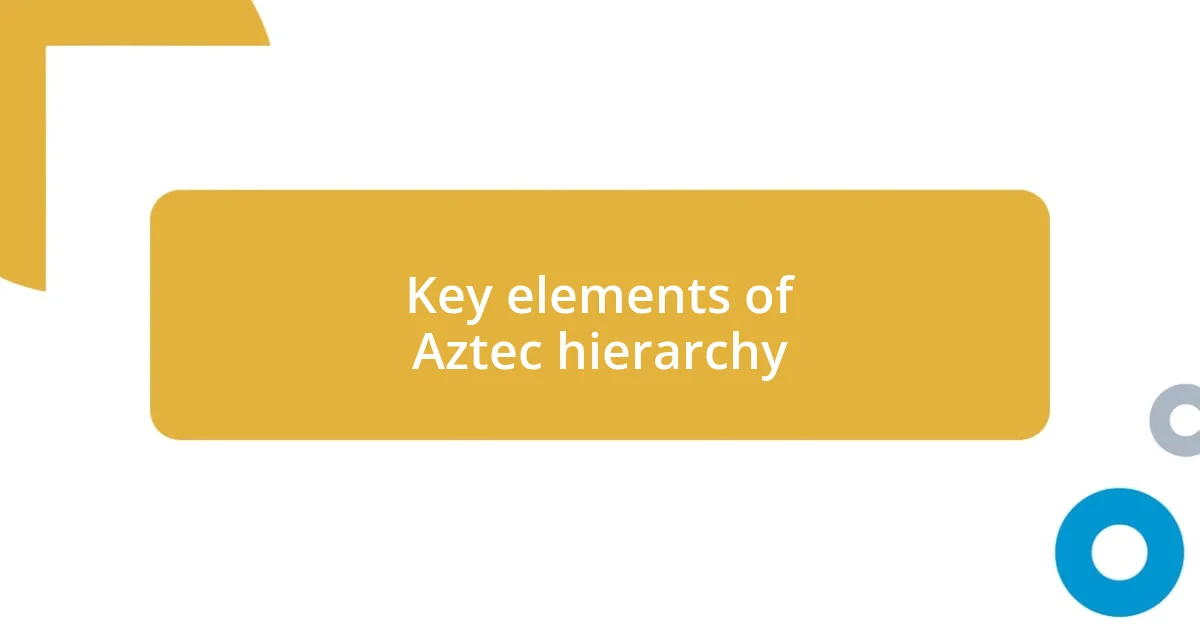
Key elements of Aztec hierarchy
The Aztec hierarchy was fundamentally structured around a class system that influenced every aspect of life. At the top was the emperor, viewed as a divine representative, which imbued the role with immense power and responsibility. I often reflect on how this mirrors the weighty expectations leaders hold today—it’s a tough position to balance governance with the will of the people.
Beneath the emperor, the noble class held significant sway, comprising high-ranking officials and priests who maintained political and spiritual order. I can’t help but feel a connection to this group; their duty to uphold the society’s values resonates with today’s leaders who strive to create a moral compass for their communities. It’s a reminder of how historical roles echo through time, influencing our current societal structures.
Warriors formed a crucial component of Aztec society as well. Their achievements in battle were not just personal triumphs but also elevated their families’ status and wealth. I remember an inspiring story of a warrior from the Aztec era whose journey exemplified the idea of bravery and honor, reminding me how personal accomplishments can impact a community, just as they do now. It’s a testament to the enduring nature of ambition and recognition.
| Class | Description |
|---|---|
| Emperor | Divine ruler with absolute power |
| Nobles | High-ranking officials and priests |
| Warriors | Defenders of the empire, earn prestige through valor |
| Commoners | Farmers, laborers, and merchants, supporting the elite classes |
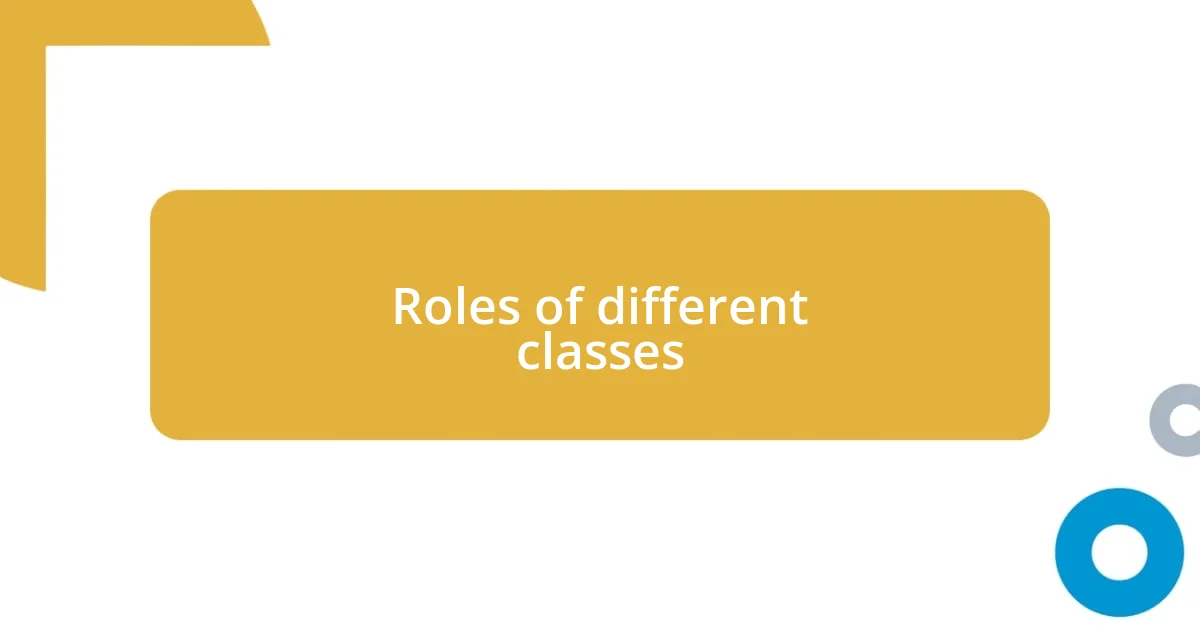
Roles of different classes
The roles of different classes in Aztec society were not just titles; they carried deep responsibilities that influenced the very fabric of their world. From my perspective, it’s fascinating to think how each class operated within a predefined purpose, contributing to both the community and the divine order. For instance, commoners were the backbone of society, embodying industriousness that resonates with me today as I appreciate the value of hard work in my own life.
- Emperor: The ultimate authority, seen as a divine figure responsible for maintaining order and wellbeing.
- Nobles: Guardians of tradition and governance, they shaped policies while also guiding spiritual practices.
- Warriors: Brave defenders who fought not just for territory but also for personal and family honor in a culture that revered valor.
- Commoners: The labor force that delivered sustenance and goods, their everyday efforts were vital for the empire’s operation.
In exploring these roles, I can’t help but feel a connection to the commoners who labored tirelessly for their families and communities. Their stories remind me of the dedication seen in everyday life today. It’s poignant how, in their quiet strength, they formed the essential foundation of a society that thrived on interconnectedness and purpose. Their sacrifices often remain overshadowed, yet they truly embody the spirit of the era, echoing the importance of the unsung heroes in any community.
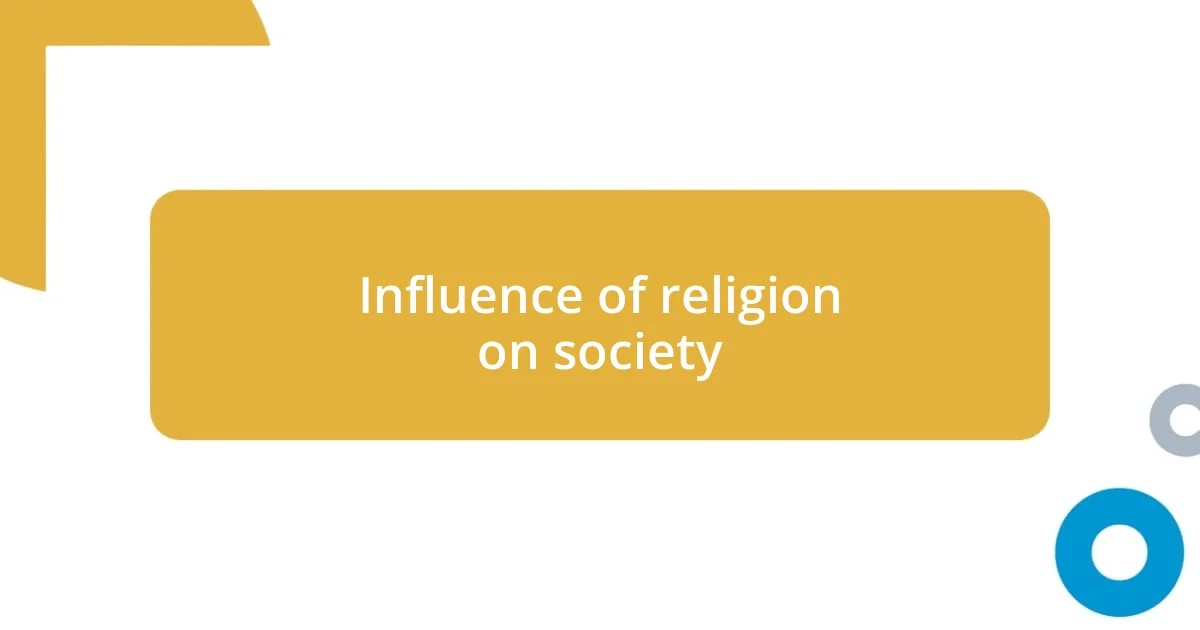
Influence of religion on society
The Aztec religion was deeply interwoven with daily life, shaping everything from governance to agriculture. I find it intriguing that their major deities were not just abstract concepts but represented vital forces in nature—like the sun, rain, and corn. This connection made their rituals come alive; I’ve often wondered how our modern faiths similarly guide our interactions with the world.
Priests held a pivotal role, acting as intermediaries between the gods and the people. They led ceremonies that governed the agricultural calendar, like the ceremonial planting of maize, which must have felt incredibly empowering. I can only imagine standing before a community, invoking blessings for a bountiful harvest, knowing that such moments held together not just faith, but also survival. It’s a striking reminder of how communal beliefs can forge strong identities and unite people with a shared purpose.
Religious festivals were vibrant expressions of devotion, featuring music, dance, and elaborate offerings. These celebrations must have created a palpable sense of unity among the citizens, fostering joy amid life’s hardships. It resonates with me as I think about contemporary festivals; they also serve to reinforce community bonds. Have you noticed how shared experiences—whether religious or cultural—can enrich our lives? In the Aztec society, these moments offered both a respite and a reaffirmation of their interconnectedness, echoing the idea that together, we draw strength from our collective faith and traditions.
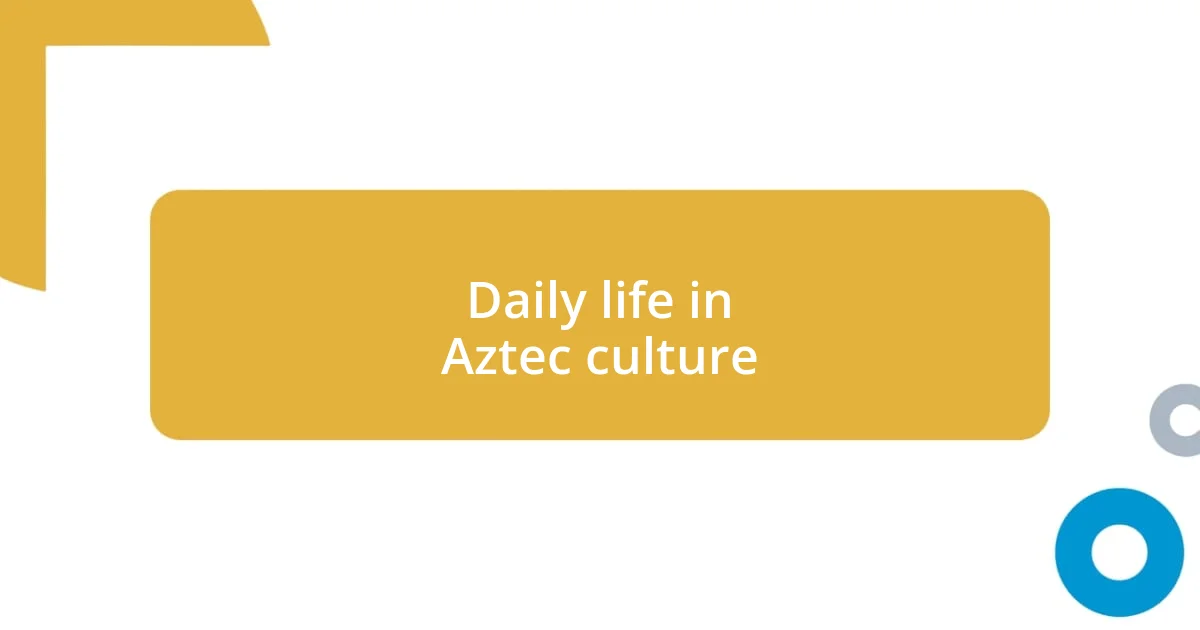
Daily life in Aztec culture
Daily life in Aztec culture was a vivid tapestry woven from the threads of work, community, and spirituality. I often think about how early mornings must have started with the sounds of bustling markets as farmers traded their fresh produce, and artisans showcased their crafts. There’s something about the rhythm of daily life that feels both grounding and invigorating; it’s a hum that connects everyone, much like the lively atmosphere I remember from local fairs in my hometown.
As I explore their society, I’m struck by the communal nature of their living arrangements. Families lived in brightly painted adobe homes that didn’t just house individuals but entire extended families. This shared space cultivated a sense of belonging; can you imagine the stories exchanged over meals cooked together? It reminds me of my family gatherings, where laughter fills the air, and we’re bound by shared traditions. The Aztecs celebrated their connections, cherishing time with relatives just like we do, reaffirming the idea that community truly enriches our lives.
Moreover, the Aztecs placed a strong emphasis on education, particularly for the young, who attended calm, organized schools. From lessons in history to practical skills, this immersive environment nurtured not just knowledge but also a sense of identity. I can’t help but reflect on how my own education shaped me—guiding my aspirations and my views—the Aztecs recognized that teaching their youth would shape the future of their civilization. Wasn’t it remarkable that they understood this importance centuries ago? The lessons learned in those vibrant classrooms echoed the values of hard work and respect that I still carry with me today.
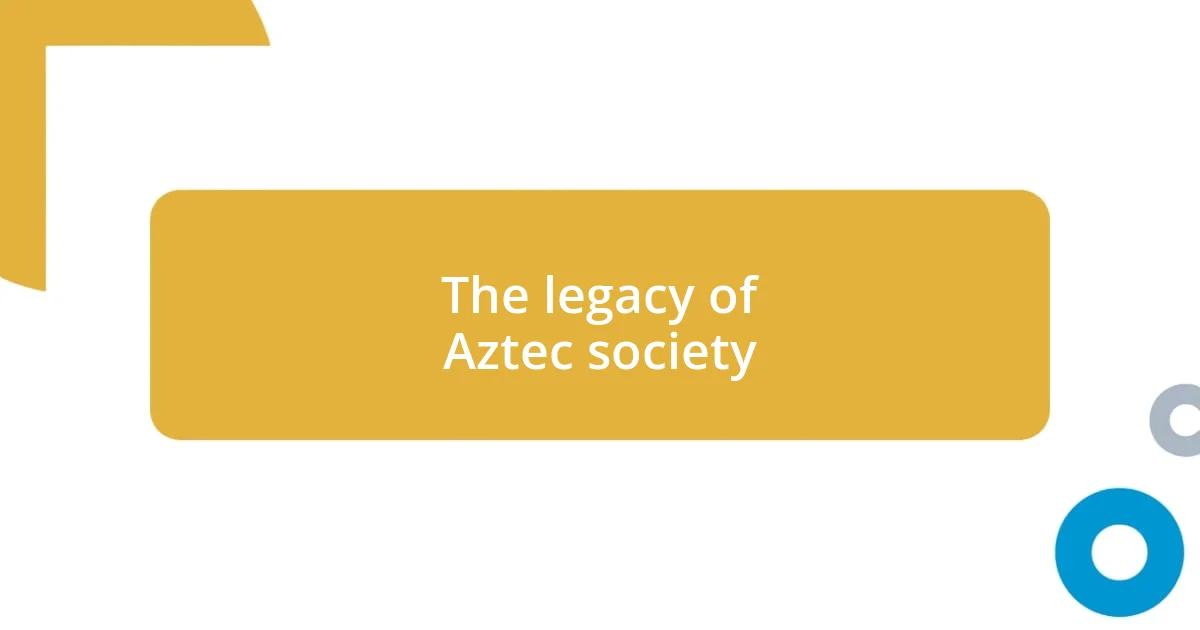
The legacy of Aztec society
The legacy of Aztec society is a fascinating tapestry of cultural practices, technological advances, and social structures that still resonate today. For instance, their sophisticated agricultural techniques, such as chinampas—floating gardens—enabled them to thrive in a challenging environment. I often think how innovative solutions like this mirror our modern attempts to address food security and sustainability. Doesn’t it make you appreciate how past societies laid the groundwork for our current practices?
In addition, the rich artistic traditions of the Aztecs offer insight into their worldview. I’ve seen stunning examples of their sculpture and pottery, which reflect their beliefs, daily lives, and connections to the cosmos. It strikes me as powerful how art serves as both a personal expression and a communal narrative. How does our own art reflect our collective experiences? Just like Aztec crafts, today’s art communicates who we are, engaging people emotionally and historically.
Their administrative and political innovations also sparked robust governance models that included tribute systems and laws. As I’ve learned about their societal organization, I can’t help but compare it to the complexities of modern governance. Can we draw lessons from their practices of accountability and communal responsibility? The way they balanced power and responsibility teaches us that strong societies depend on the involvement and well-being of every member, a lesson that remains critical as we navigate our own complex social dynamics.




